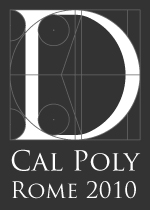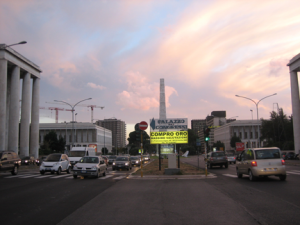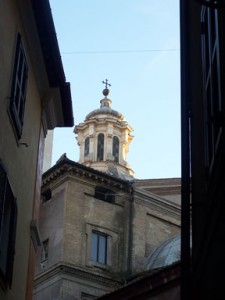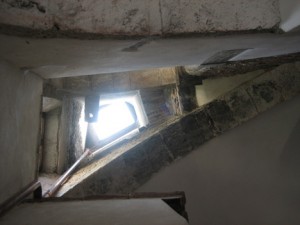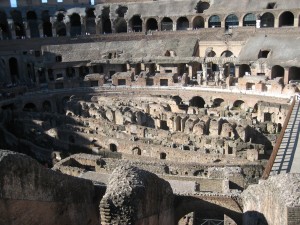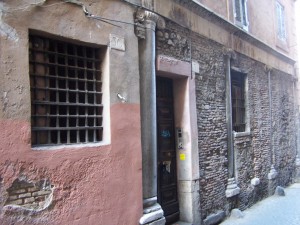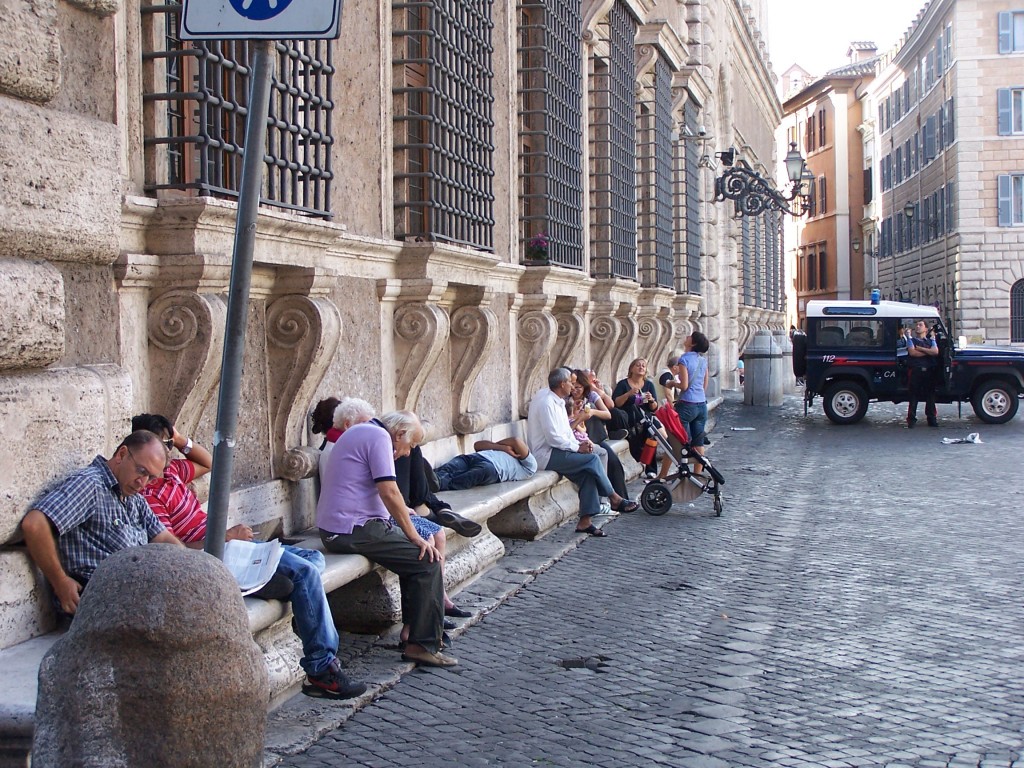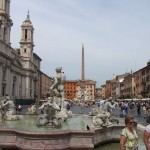How is history made active?
The E.U.R. is a very different part of Rome. This planned city, built during the Fascist era, was an attempt to display the greatness of Italian culture to the rest of the world through an international exposition.
Rather than draw from existing historical monuments, or religious sites Mussolini tried to impose a new language of Italian architectural identity into history both visually and contextually. Buildings found throughout the area mimic the scale, form and materials of ancient historical buildings found throughout Rome, such as the Pantheon, Coliseum, and the obelisks. A relief mounted at the entry of the Palazzo degli Uffizi literally places Mussolini at the end of a timeline of well-known people, buildings and events celebrated in Roman history.
For many reasons the E.U.R. proposal failed to capture identity of the Italian people. However, this historically significant area has grown to actively demonstrate what the Italian Identity has in some ways become. Events never intended in the original plan have since taken place in the area. The multi-lane boulevards filled multitudes of cars, numerous McDonalds, and large homes of the city now represent the fast-paced, glitzy lifestyle of the U.S., while other areas are home to a variety of asian immigrants. “Gay-pride” and “OctobEUR fest” festivals take place in an area few tourists rarely see. Although the E.U.R. was an attempt by a political body to legitimize its identity through its country’s strong architectural tradition, the E.U.R. project like Fascism itself, fell short of its intended goals.
What does “this” map tell you about the city of Rome?
Since arriving in Rome I have been determined, much to the frustration of my girlfriend, not to use a map. I would prefer to blend in, or appear to know where I am going, even when I am not entirely sure. I have organized a series of landmarks
into my map of Rome. I know what street to turn down towards the restaurant we can’t even seem to pronounce correctly when I see the Forza Roma graffiti. If walking home from the north, I know I am close to Via del Governo Vecchio when I can see the dome of Saint Agnese in Agone, and know where I am on Via del Corso depending on whether I am looking towards the obelisk or the “wedding cake”. A map can be more than just a piece of paper. A mind’s map is a series of relations that help you move through a space, whether it is a neighborhood, or a city.
What stands between a mountain and the sea?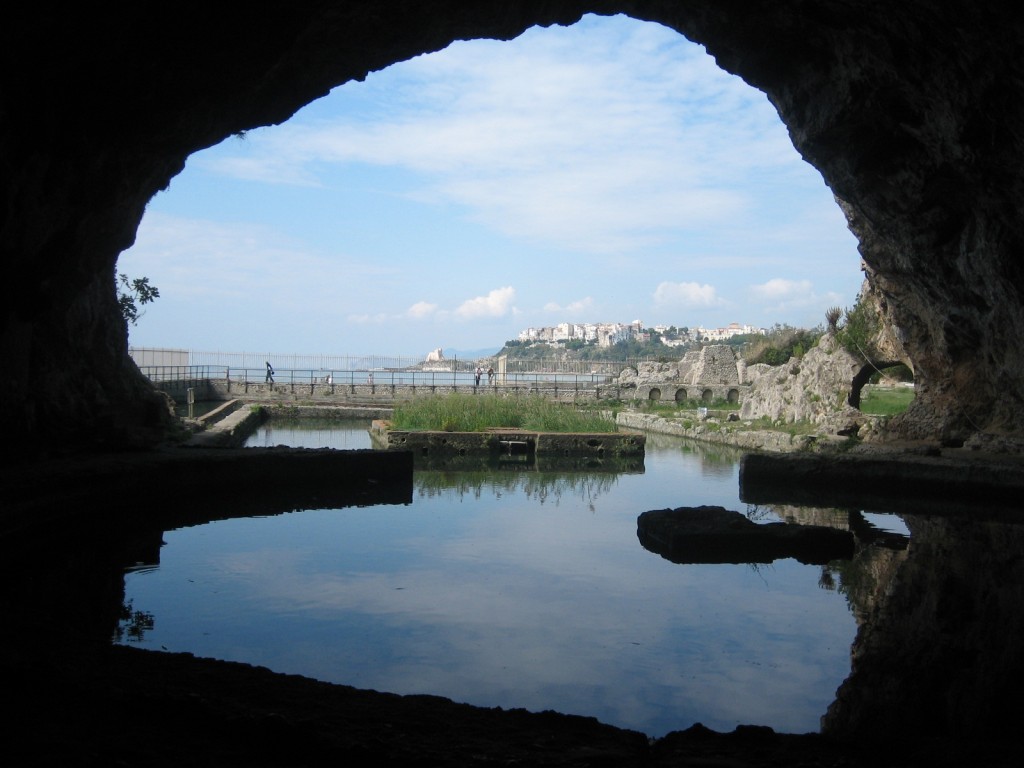
Depending on the distance between a mountain and the sea, a lot. All that is required to manipulate what occupies this space is a little imagination. Sperlonga is home to two very different examples of how the space between, or lack thereof, can still be manipulated to create unique places of paradise. The old town itself sits atop a point that abruptly drops down to the sea, yet the whitewashed homes seem as rooted in the terraced topography of the craggy point as much as the cacti and agave plants scattered throughout. A little ways to the south, along the same stretch of beach, the remains of Tiberus’ grotto remain tucked into a cave that feeds directly out into the sea. Rather than sit above the mountain, the emperor chose to dine along the exact interface where stone meets sea. Its as if the ancient Roman ruler understood man’s vulnerability to nature, and intended to keep this place only for himself, a personal monument to nature’s power, knowing it would some day be recaptured by the sea.
As we traveled from Rome into the Abruzzo region, several things became immediately apparent. The amount of open space greatly increased, while the size of buildings and populated areas decreased. Our destination Castelvecchio Calvisio, a town of less than 200 people, could have easily fit into one of the numerous large buildings spread throughout Rome. So how does a big building differ from a small city? The most noticeable trait of large Roman buildings is the sense of monument. In some cases, large buildings actually perform the same functions as a small city, by providing a place for performance of a common ritual, while reflecting social customs, and acts in its program.
The Coliseum is a perfect example. Even in partial ruin, it still holds the ability to entertain large masses, far larger than the population of Castelvecchio Calstino, and create a sense of wonder. The size of the arena where the events took place, takes up an area as large as the town of Castelvecchio Calstino. The building itself has always served as a monument to Roman grandeur, power, and architectural techne.
As a small town crumbles over time, roof collapse and walls fail, forever obscuring the sense of place that made it so unique. Even in ruin, the Colisseum still grants hundreds of people, everyday, the ability to visualize what makes it so special, while another small city slowly closes in on crumbles into obscurity.
Building 1: “Did you see the way he looked at me?!”
Building 2: “Yeah, yeah, he probably stares like that all of the time…”
Building 1: “I dunno, he was really staring. He couldn’t take his eyes off me, and the way he kept looking up and down my legs….”
“Building 2: ” Whatever, it’s not a big deal”
Building 1: “Not a big deal? How can you say that? I love when a young man still looks at me like that, he even took a few pictures…It’s nice to know I can still turn some heads! Listen we’re not getting any younger! You should want them to still look at you.
Building 2: “I don’t know, I don’t like attracting a ton of attention.”
Building 1: You know what your problem is? You’re too conservative. Even when we were younger, it was the same thing. You don’t have to go out of your way to show off everything, but c’mon, at least show some leg, guys love that! You need to celebrate what you have, not hide it. If you keep it all hidden, how is anybody going to know it’s even there? By showing some leg, you’re not being gaudy, you’re being honest!”
Building 2: “Hmmm, that’s a good point, I guess I could show off a little here and there.”
As he sits along the base of Palazzo Pichini in Piazza Farnese, an old man quickly falls alseep while listening to the words of his wife.

How does a building meet the ground?
Located between the Tiber River and a upscale neighborhood to its north, Castel San Angelo is one of those unique places in the city where the use of the site becomes entwined within the daily routines of local residents, but only along its fringes. Along the defensive perimeter, two open spaces ring the castle roughly 15 feet below its main level, separated only by a shady promenade. One is a narrow grassy space used primarily by locals to run their dogs. Since no stairs lead from the main grounds down to the lower space, it is not readily accessible to the tourists viewing the castle. The second open space however, located immediately around the castle, is far more inviting to all the masses, due to the presence of a large ramp and stairs that descend down to the park from the promenade above.
Upon descending down into either space, the appeal becomes apparent. The retreat away from the noise, tourists, and traffic from the castle and streets above is immediately noticeable. The defensive measures of the castle now serve an inverse function, keeping travelers inside. The castle’s neighborhoods to the north are largely left unscathed by the hordes of invaders who stream back and forth across Ponte Castel San Angelo on their daily incursions.
How do I know I am in Rome?
As I walk through my neighborhood, I immediately become inundated by sounds, smells, tactile and visual sensations that I am unaccustomed to. While these sensations are foreign to me, on their own, they do not specifically locate me in Rome. Every morning, I awake to the incredible smell of freshly baked pane and pastries, along with loud Italian music being played from the kitchen of the pastericcia below. While the music is Italian, it is not particular to Rome. As I walk down our streets I experience more unusual sensations, such as the feel of the uneven stones underneath my feet and the casual conversations of Italian passerbys. Again, these sensations base me in Italy, but not necessarily in Rome. I know I am in Rome when I walk two blocks from our new apartment and reach the massive open space of Piazza Navona. The oval shape of the piazza, which comes from the racetrack that once occupied the site during the Roman Empire, holds three fountains. The central fountain, the Fontina dei Quattro Fiumi, supports a large obelisk that demands the attention of everyone entering the space. This fountain, created the Roman architect Bernini, is composed of a large obelisk taken from ancient Egypt during the Roman Empire, and supported by four large figures representing the four major rivers known to exist at the time of its creation. A magnificent church by Borromini overlooks the fountain, as do numerous multi-story, colorful baroque-style buildings. Scattered around these amazing architectural features, I see numerous cafes filled with people, hear musicians entertaining the crowds, and visitors from all over the world strolling trough the piazza, snapping photos or cooling off around the fountains. This piazza is a model of Roman life as it has been for many centuries- where the daily routines of people from all over the city, Italy, and the world play out on a stage where various monuments of size, scale, and time periods serve as their backdrop. It is here I know I am in Rome.
